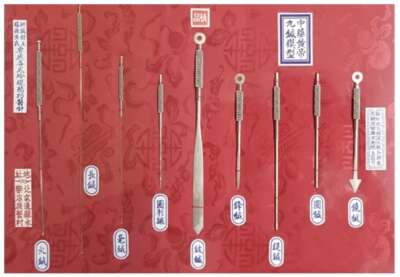
For many people, the thought of using a needle to help relax the body, ease pain and calm the nervous system, may seem a little insane. But for those who have experienced the blissful magic that acupuncture needles can provide, the word needle has a whole different connotation.
Say the word “needle” and someone within earshot is likely to cringe. That is, unless, they know the gentle, yet powerful magic and wonder of the acupuncture needle.
In tracking the evolution of the acupuncture needle from its origins to its present day incarnation, we inevitably survey the history of acupuncture itself. There are, as is true of most ancient practices, gaps in the story, unknowns that will likely forever remain mysteries. But, we have a general notion of how things went.
Acupuncture is presumed to have its origins in blood ritual, magic tattooing and body piercing associated with Neolithic healing practices. The Neolithic origin hypothesis is supported by the presence of nonfigurative tattoos on the Tyrolean Ice Man (Ötzi), an inhabitant of the Oetztal Alps in Europe, whose naturally preserved 5,200 year old body displays a set of small cross-shaped tattoos that are located significantly proximal to classical acupuncture points.
Many of Ötzi’s 61 tattoos were located at or near acupuncture points traditionally used to treat conditions such as arthritis, heart disease, digestive disorders and osteochondrosis, all of which Ötzi evidently suffered from. All of this suggests that acupuncture existed long before its emergence as a medical practice in Asia some 2,000 years later. This therapeutic tattooing style of acupuncture is still practiced by several cultures, including the Kayan people of Borneo, whose markings resemble those of Ötzi’s. It is also prevalent in Tibet, where medicinal herbs are blended into the tattoo inks.
In the Neolithic Era (when Ötzi lived), stone and bone needles constituted the first acupuncture tools. In ancient China, stones (i.e., Bian stone) were shaped into therapeutic tools with sharp tips or edges used in bloodletting, incising and acupressure. These might be viewed as the predecessors to modern acupuncture and gua sha tools. Animal bones and horns, bamboo, pottery and later metal, such as bronze, iron, tin, copper, gold and silver, were used to fashion early needles.
Ancient Chinese practitioners had nine types of metal needles, originally utilized just over 2,000 years ago. The ‘nine needles’, which are explained in the Yellow Emperor’s Classic of Internal Medicine, included:
- a large needle to puncture aching joints and drain interstitial fluid
- a long needle to penetrate thick muscles and treat chronic rheumatism
- a filiform ‘threadlike’ needle (this is the primary type currently utilized for acupuncture)
- a round sharp needle to prick swiftly and discharge pus
- a sword-like needle to drain abscesses and perform surgical procedures
- a three-edged needle to puncture veins (bloodletting)
- a blunt needle (with a tip like a millet seed) to press along the meridians (acupressure)
- a cylindrical needle with a round tip for massaging
- and an arrowhead needle to prick superficially and bloodlet.
The needles of today may be similar in appearance and application to those of the past, but they differ considerably in material, manufacturing, size and quality. China began using steel in the fourth century AD. Modern needles are standardized and sterile, single-use, disposable filiform needles made of stainless steel. They vary in length (from about 13 to 130 mm) and width (aka gauge, from about 0.12 to 0.50mm). A blind Japanese acupuncturist named Waichi Sugiyama invented the guide tube In the 17th century, which allowed for the production of even thinner needles. And in 1995, the FDA designated acupuncture needles as medical instruments.
Today, there are many different brands of needles for acupuncturists to choose from. In selecting a preferred needle choice, the practitioner takes into account the quality and type of materials used (in the needle shaft, handle, etc.), sharpening and sterilization methods, production and packaging facilities and quality control standards. Style of treatment and patient comfort are also essential considerations in needle choice, as the needles used can impact the experience and outcome of treatments.
When it comes to the “tools of the trade”, the needle is to the acupuncturist as the wand is to the magician, and it is wielded just as preciously. Our primary and powerful instrument has undergone numerous adaptations since the Stone Ages, and has cycled in and out of the embrace of popular culture across the globe. The acupuncture needle has been modernized alongside the devices of Western medicine and will undoubtedly continue to evolve with the needs and ingenuity of those who value it.

